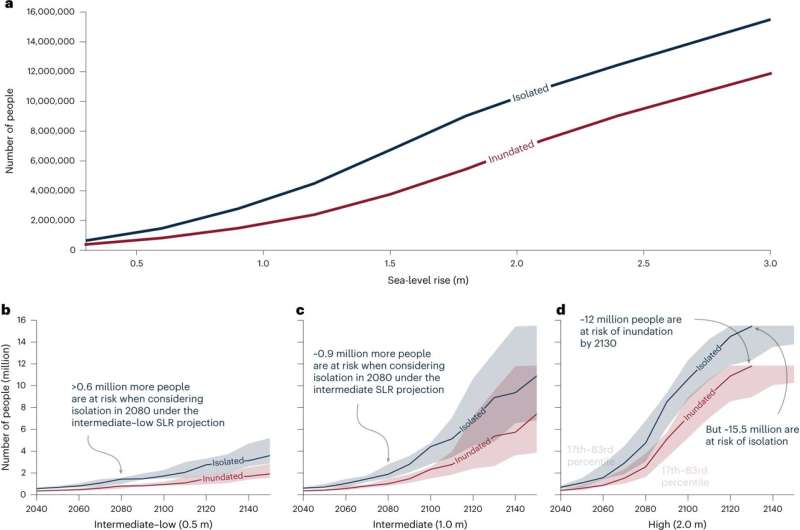Mapping the risks of isolation due to sea level rise associated with global warming
A trio of environmental engineers, two with the University of Canterbury in New Zealand, the third with the University of Maryland, has developed a way to illustrate the impact of sea level rise isolation associated with global warming.
In their paper published in Nature Climate Change, Tom Logan, M. J. Anderson and Allison Reilly describe mapping isolation areas along both coasts of the U.S. and used the maps to calculate how many people would be impacted. Logan and Reilly have also published an associated Research Briefing in the same journal issue outlining their work.
As climate change progresses, ice on mountaintops and in the Antarctic and arctic regions continues to melt, resulting in a rise in ocean levels. Prior research has typically focused on areas that will be submerged, such as islands and coastal city areas. In this new effort, the researchers point out that another problem will arise—isolation. They note that rising coastal sea levels could encircle some areas, leaving those living or working on higher ground isolated.
They also note that sea level rise could also cover some roadways, preventing people from driving from point to point—another type of isolation. Either type of isolation, they note, could be permanent, or periodic, coinciding with tides or heavy rains. They also note that such types of isolation could prevent people from traveling to places such as the grocery store, their school, or the hospital, forcing them to move.
In this new effort, the researchers sought to calculate the number of people in the U.S. (the lower 48 states) that would be impacted by such types of isolation based on three different levels of ocean rise; 0.5, 1.0 and 2.0 meters by the end of the century.
To conduct their calculations, the team first created a map using OpenStreetMap to depict those coastal areas at risk of isolation. They then compared their maps with sea level impacts projected by NOAA. Then finally, they tracked all such neighborhoods and compared them with nearby essential facilities such as schools, hospitals and grocery stores. They found that approximately 500,000 people will likely experience isolation by the year 2080 under the 0.5-meter sea rise scenario, and that the number will rise to over 1 million under the 1-meter sea rise scenario.
More information:
T. M. Logan et al, Risk of isolation increases the expected burden from sea-level rise, Nature Climate Change (2023). DOI: 10.1038/s41558-023-01642-3
Risk of isolation increases the urgency and spatial extent of climate change adaptation, Nature Climate Change (2023). DOI: 10.1038/s41558-023-01647-y
© 2023 Science X Network
Citation:
Mapping the risks of isolation due to sea level rise associated with global warming (2023, March 27)
retrieved 27 March 2023
from https://phys.org/news/2023-03-isolation-due-sea-global.html
This document is subject to copyright. Apart from any fair dealing for the purpose of private study or research, no
part may be reproduced without the written permission. The content is provided for information purposes only.

A trio of environmental engineers, two with the University of Canterbury in New Zealand, the third with the University of Maryland, has developed a way to illustrate the impact of sea level rise isolation associated with global warming.
In their paper published in Nature Climate Change, Tom Logan, M. J. Anderson and Allison Reilly describe mapping isolation areas along both coasts of the U.S. and used the maps to calculate how many people would be impacted. Logan and Reilly have also published an associated Research Briefing in the same journal issue outlining their work.
As climate change progresses, ice on mountaintops and in the Antarctic and arctic regions continues to melt, resulting in a rise in ocean levels. Prior research has typically focused on areas that will be submerged, such as islands and coastal city areas. In this new effort, the researchers point out that another problem will arise—isolation. They note that rising coastal sea levels could encircle some areas, leaving those living or working on higher ground isolated.
They also note that sea level rise could also cover some roadways, preventing people from driving from point to point—another type of isolation. Either type of isolation, they note, could be permanent, or periodic, coinciding with tides or heavy rains. They also note that such types of isolation could prevent people from traveling to places such as the grocery store, their school, or the hospital, forcing them to move.
In this new effort, the researchers sought to calculate the number of people in the U.S. (the lower 48 states) that would be impacted by such types of isolation based on three different levels of ocean rise; 0.5, 1.0 and 2.0 meters by the end of the century.
To conduct their calculations, the team first created a map using OpenStreetMap to depict those coastal areas at risk of isolation. They then compared their maps with sea level impacts projected by NOAA. Then finally, they tracked all such neighborhoods and compared them with nearby essential facilities such as schools, hospitals and grocery stores. They found that approximately 500,000 people will likely experience isolation by the year 2080 under the 0.5-meter sea rise scenario, and that the number will rise to over 1 million under the 1-meter sea rise scenario.
More information:
T. M. Logan et al, Risk of isolation increases the expected burden from sea-level rise, Nature Climate Change (2023). DOI: 10.1038/s41558-023-01642-3
Risk of isolation increases the urgency and spatial extent of climate change adaptation, Nature Climate Change (2023). DOI: 10.1038/s41558-023-01647-y
© 2023 Science X Network
Citation:
Mapping the risks of isolation due to sea level rise associated with global warming (2023, March 27)
retrieved 27 March 2023
from https://phys.org/news/2023-03-isolation-due-sea-global.html
This document is subject to copyright. Apart from any fair dealing for the purpose of private study or research, no
part may be reproduced without the written permission. The content is provided for information purposes only.
